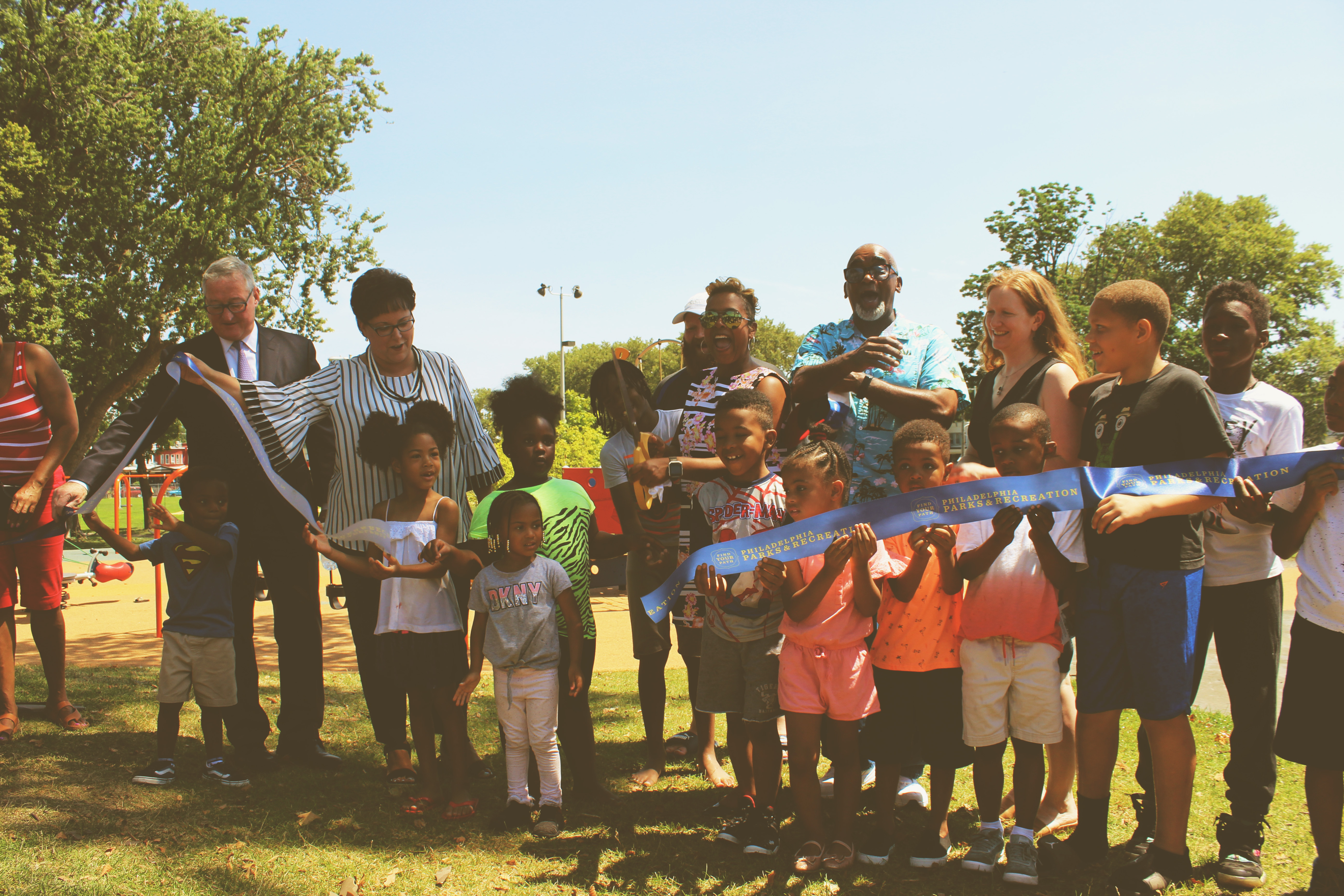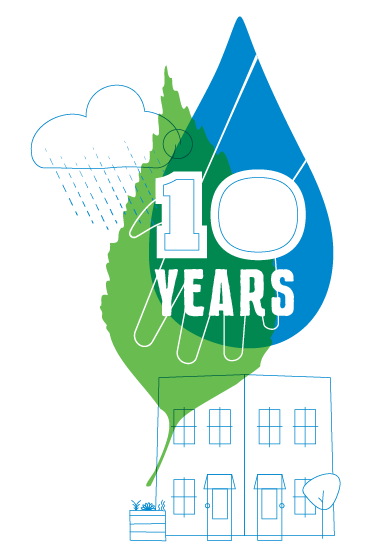 Look across Philadelphia. You may notice traffic-calming bumpouts down the block, tree trenches surrounding your local park, or rain gardens soaking up runoff at your child’s school.
Look across Philadelphia. You may notice traffic-calming bumpouts down the block, tree trenches surrounding your local park, or rain gardens soaking up runoff at your child’s school.
Green stormwater tools are different from other infrastructure because you can often see and touch them; they improve our daily lives in small but tangible ways. Green Stormwater Infrastructure (GSI) is everywhere in Philadelphia, thanks in large part to our partners—an indispensable component of Green City, Clean Waters.
Over the past decade, a monumental force in the success of Green City, Clean Waters has been ongoing support from external entities. Whether City agencies or community organizations, companies or non-profits, operations large and small have helped shape the last decade of this 25-year plan.
Without the hearts and minds of water warriors across Philadelphia, we would not be here today.
As we conclude this nearly year-long campaign (and the first decade of Green City, Clean Waters), we’d like to extend a sincere and heartfelt thank you to our partners who support this incredible mission.

Public Partnership Highlights

Collaboration across City and public agencies is key to making Green City, Clean Waters successful.
These partnerships were critical in meeting our five-year goals in 2016 and remain crucial during this 10-year milestone. To get to our 2036 goal of 85% pollution reduction, we will need their continued advocacy, dedication, and teamwork.
If you look at Philadelphia’s impermeable surfaces (the source of most of our water pollution, where ‘runoff’ originates) most of this land is City or publicly owned, including places such as parks, schools, and streets.
To completely execute this 25-year vision, and meet all milestones along the way, we had to partner with the owners of these impermeable surfaces, including Philadelphia Parks & Recreation, the School District of Philadelphia, and Philadelphia Streets Department. In addition to these partnerships, we also work closely with City Council and the Mayor’s Office. These partners recognize the power of collaboration to improve these spaces while managing stormwater.
Philadelphia Parks & Recreation
Philadelphia Parks & Recreation (PPR) is an indispensable partner.
PWD and PPR have a historic connection, with both protecting land and water in Philadelphia for hundreds of years.
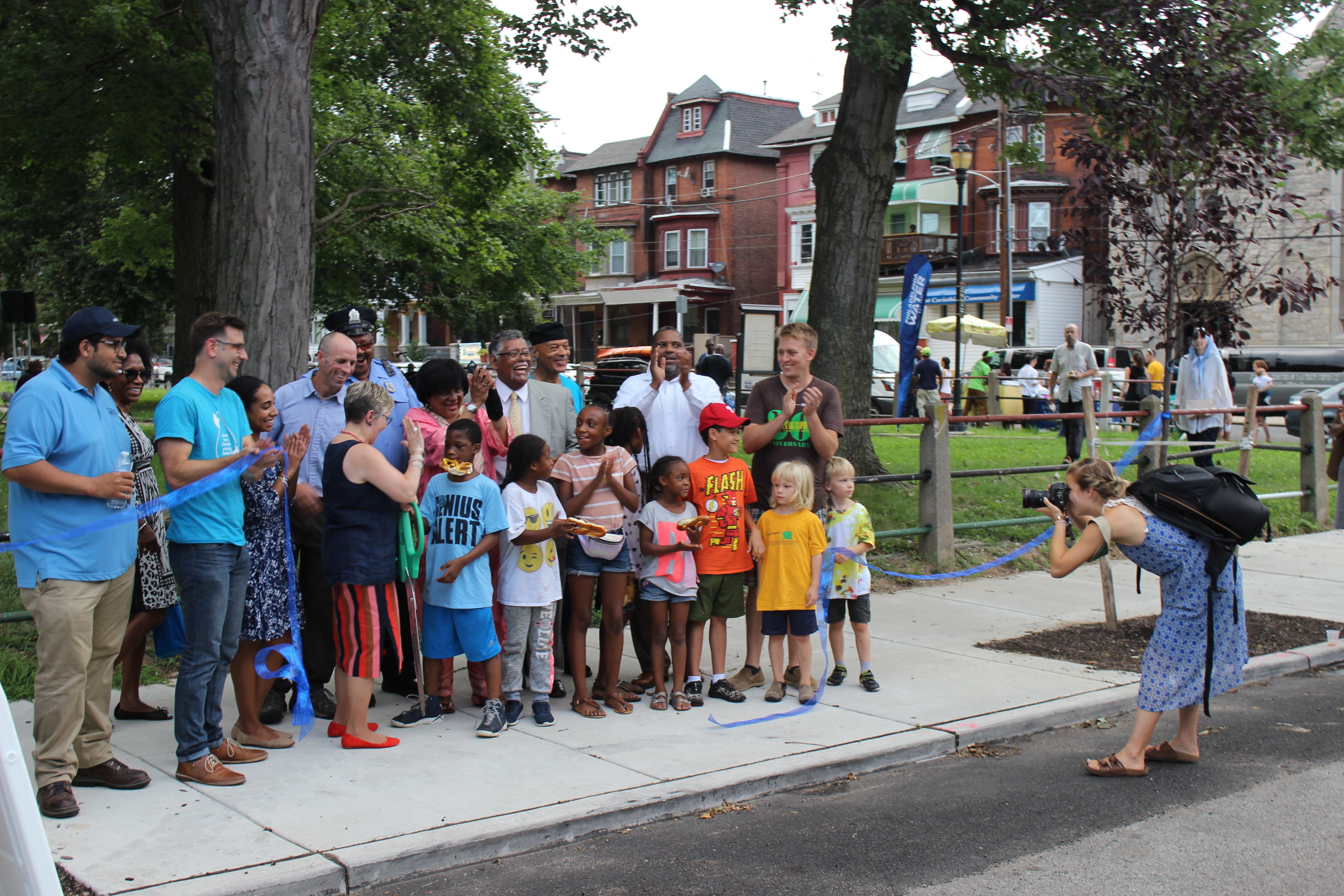
In 2018, neighbors and representatives gathered for a ribbon cutting led by PWD to welcome new GSI features at PPR’s Malcolm X Park in Cobbs Creek.
There are more than 1,000 acres of PPR parks in the combined sewer systems, and many thousands more acres of PPR watershed parks at the edges of the combined sewer systems, providing significant open space in which to manage runoff from surrounding streets.
We work with PPR to engineer ways for water to flow into parklands, and then build GSI, such as rain gardens landscaped with native plants or subsurface basins beneath fields, to hold, store, and slowly release this water back into the natural world.
Since the start of Green City, Clean Waters, we’ve partnered with PPR on the design and construction of holistic projects that feature GSI as well as other improvements to park sites. This process includes coordinating with park-friendly entities such as Fairmount Park Conservancy, Make the World Better, the Philadelphia Parks Alliance, and City Council, that help to fund recreational components of stormwater investments, like playgrounds, benches, or lighting.
Our work with PPR often triggers secondary benefits such as formalized maintenance plans and the beautification of parks and recreation centers, which can lead to safer places to play and gather.
PWD also coordinates with the Rebuild program to maximize the amount of stormwater managed through their projects, especially if the new investments trigger PWD Stormwater Regulation requirements.
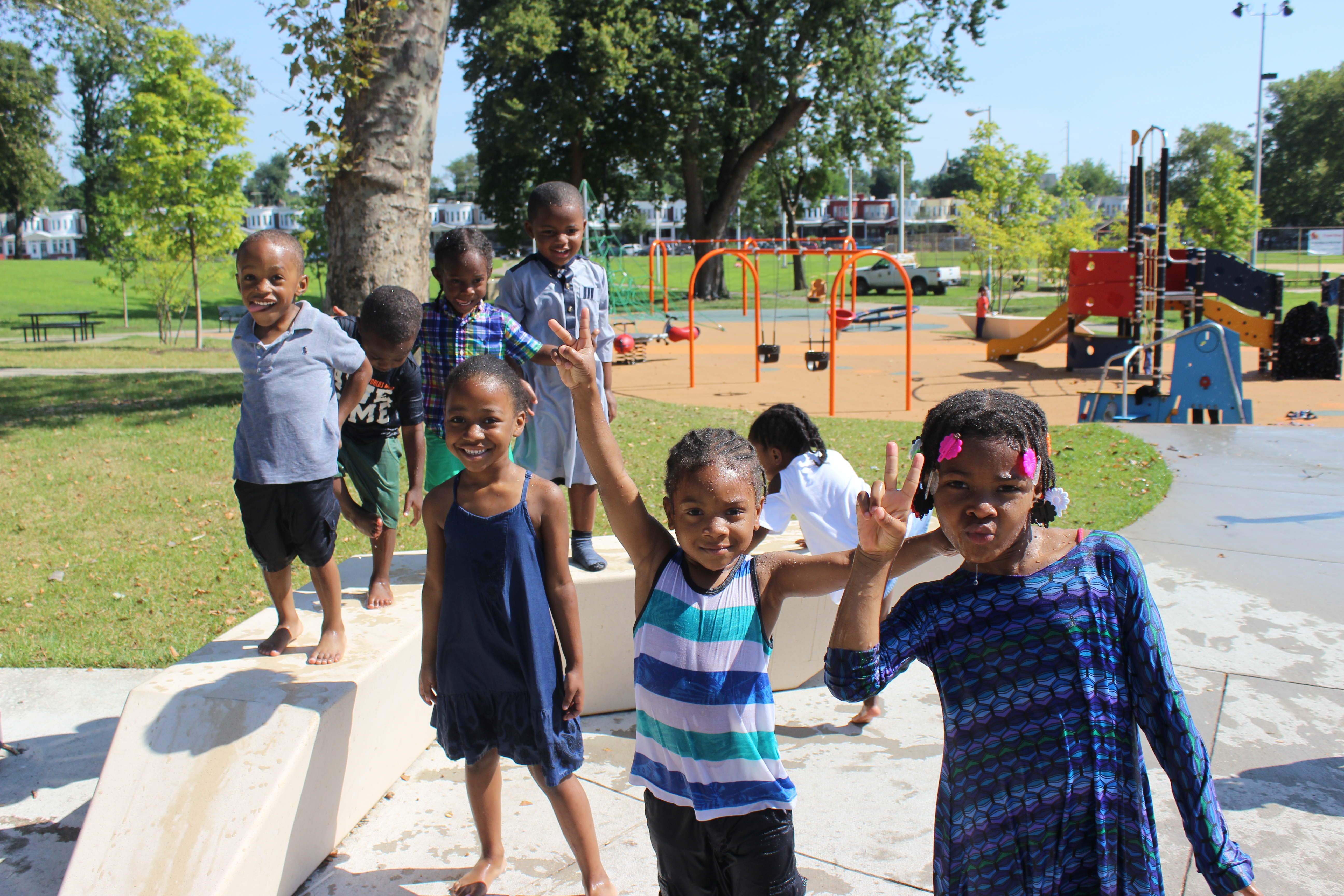
In 2019, children gather at PPR’s Stenton Park in Nicetown. The North Philly playground features GSI. (Photo: PPR)
“In the last 10 years, Green City, Clean Waters has transformed Philadelphia’s parklands,” says Kathryn Ott Lovell, Commissioner of Philadelphia Parks & Recreation. “Whether it’s showing residents how native vegetation helps keep waterways clean or by cutting the ribbon on a stormwater infrastructure project, Parks & Rec is proud to partner with the Water Department to help naturally manage runoff. These projects will amplify the beauty and functionality of our green spaces in the years to come.”
PWD, PPR, and project partners have collectively completed more than 50 projects to date, which manage more than 5 million gallons* of stormwater runoff per typical storm event. That’s equivalent to over eight Olympic-sized swimming pools full of polluted water that no longer flow into our waterways!
*Or 180+ Septa buses, or 76,000+ bathtubs, or almost 97,000 55-gallon rain barrels per storm.
Philadelphia Schools
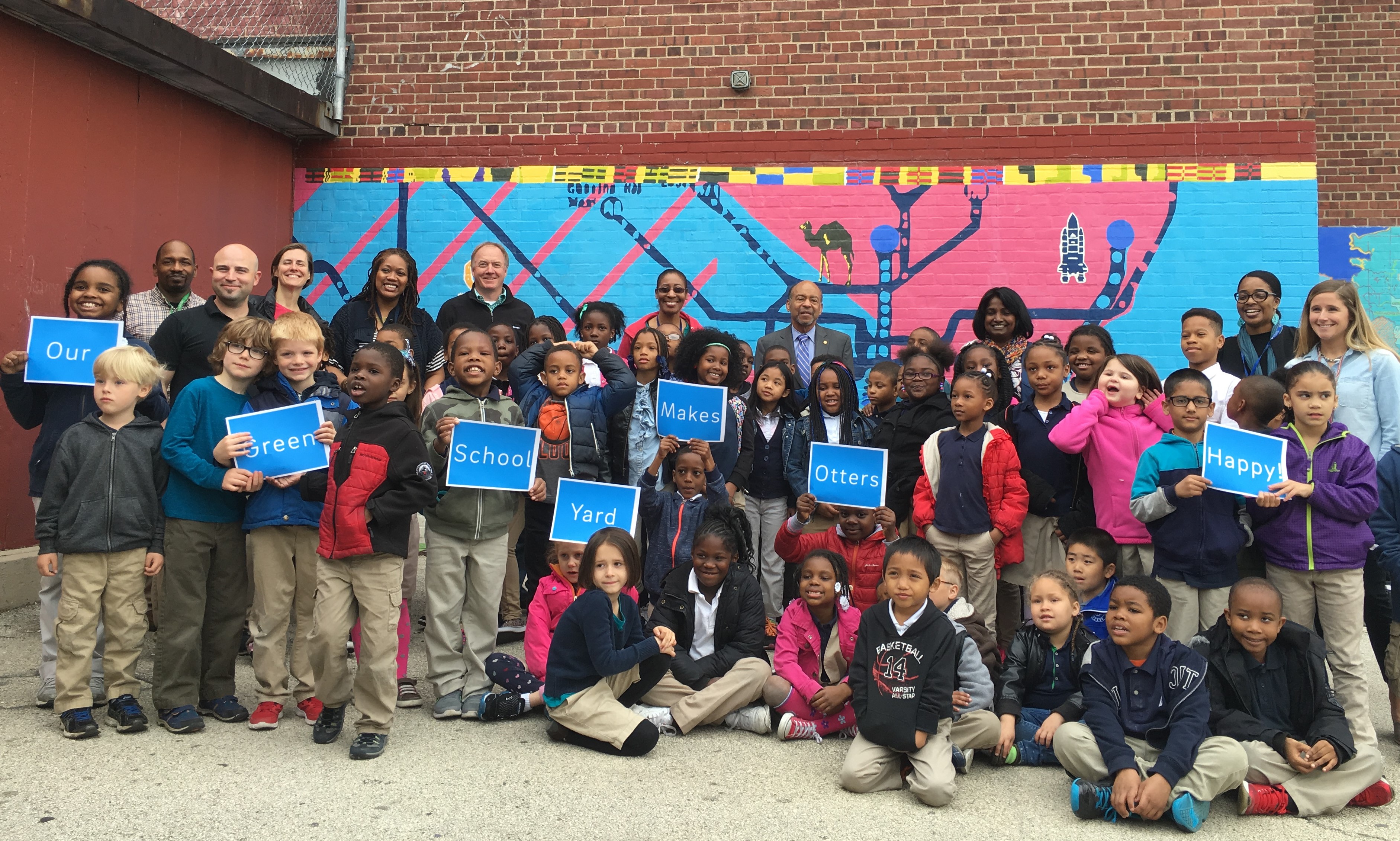
In 2016, Henry C. Lea School in the Walnut Hill neighborhood of West Philadelphia received three rain gardens, nearly two dozen new trees, porous paving, and play surfaces.
The School District of Philadelphia (SDP) continues to be a formative partner of Green City, Clean Waters.
Since schools are community hubs that attract a wide spectrum of stakeholders, management of stormwater on school properties can spark partnership and stewardship in various forms.
PWD’s partnership with the SDP started early in our watershed-based work and continued through our Green City, Clean Waters program as we explored various options to guide and support greening schoolyards through stormwater management. Our partnership with SDP benefits Philadelphia in many ways, including protecting our waterways through GSI, enhancing equitable access to green space, addressing urban heat island effects, and encouraging outdoor learning for students.
We support our teachers with the necessary resources to create new GSI-based curriculums—both inside and outside of the classroom. Students can become stewards of on-site vegetation, such as rain gardens. Engaged students can take this information home to inspire their parents to make changes to their homes or businesses, such as installing rain barrels or planting native pollinators.
This educational relationship goes back to the beginning of Green City, Clean Waters.
In 2014, we collaborated with the Partnership for Delaware Estuary, EcoExpress, the Fairmount Water Works Interpretive Center and other partners to develop the Understanding the Urban Watershed Curriculum Guide. The resource was designed to educate middle school students on various topics, including stormwater and watershed stewardship. It was piloted at George W. Nebinger School in South Philadelphia.
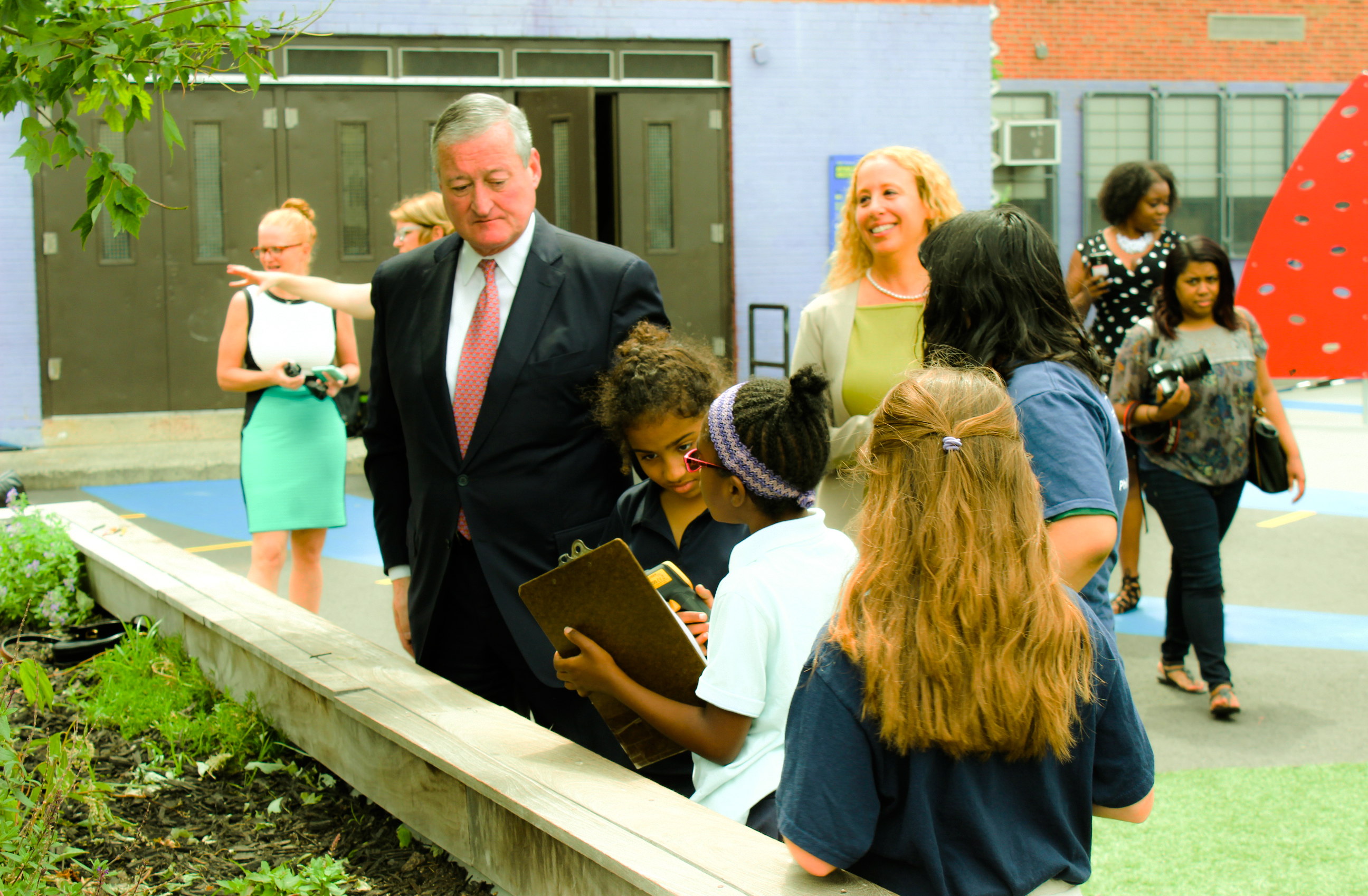
In 2017, students of Chester A. Arthur in Graduate Hospital show Mayor Jim Kenney their new schoolyard, which integrates green stormwater infrastructure with STEM learning.
Soon thereafter, the SDP started work on a sustainability plan, GreenFutures, in 2016. GreenFutures encompasses five areas of focus: efficiencies, engagement, equity, environment, and education, with goals set over a five-year period. Encompassed in this program, is the “School Greenscapes” initiative, which aligned with the District’s existing effort to install green stormwater infrastructure on its properties, outlining a goal to add five GSI projects per year.
Currently, more than 40 School SDP schoolyards have formally engaged with us to implement green stormwater infrastructure.
SDP, along with school groups, “Friends of” groups, and other established organizations, like the Trust for Public Land (TPL), fundraised around these projects, which further transformed these spaces through the introduction of additional features, like playgrounds. Many individuals and organizations, such as the Community Design Collaborative (CDC), supported pro-bono conceptual designs to kick start a variety of these GSI schoolyard efforts. In 2015, PWD collaborated with the CDC on the Transforming Schoolyards publication to help guide schools and communities with schoolyard greening.
“In striving for all schools to be both green and great, the School District of Philadelphia salutes PWD on 10 successful years of Green City, Clean Waters,” says Emma Melvin, Green Infrastructure Program Manager for the School District of Philadelphia. “This plan is impactful in so many interrelated ways – taking positive steps toward greening both our curricula and our schoolyards protects our local waterways while simultaneously exposing students and staff to interrelated educational concepts and gets them outside – all critical for higher-order teaching and learning. Congrats PWD and keep it up!”

Last November, the School District of Philadelphia was named the 2021 Stormwater Pioneer for its exceptional maintenance of GSI at 13 schools.
In fact, the School District was recently named the 2021 Stormwater Pioneer!
The GSI projects created by SDP and all school partners collectively manage 2 million gallons of stormwater runoff per typical storm event. That’s equivalent to over 3 Olympic-sized swimming pools* full of polluted water that no longer flow into our waterways!
*Or 75+ Septa buses, or 32,000+ bathtubs, or almost 41,000 55-gallon rain barrels per storm.
PWD aims to continue this strong partnership with SDP across the city to work toward protecting and improving watershed and community health and resiliency.
Philadelphia Streets Department
As the landowner with the largest area of public impermeable surfaces in the City, there is a synergistic connection between the Streets and Water Departments. This relationship is as functional as it is necessary, as the Streets Department maintains the pathways that we use to lead water to collection places (such as city inlets).
It’s critical that we maintain a partnership with Streets since they’re responsible for the planning, design, and care for these invaluable community transit ways, such as streets and sidewalks.
Similar to our work with other city agencies, our partnership with the Streets Department often leads to secondary benefits, especially traffic calming and bike/pedestrian safety – all while leveraging agency time and resources to maximize taxpayer dollars. This is evident in the completed American Street Improvement Project and the upcoming Cottman Avenue Streetscape project.
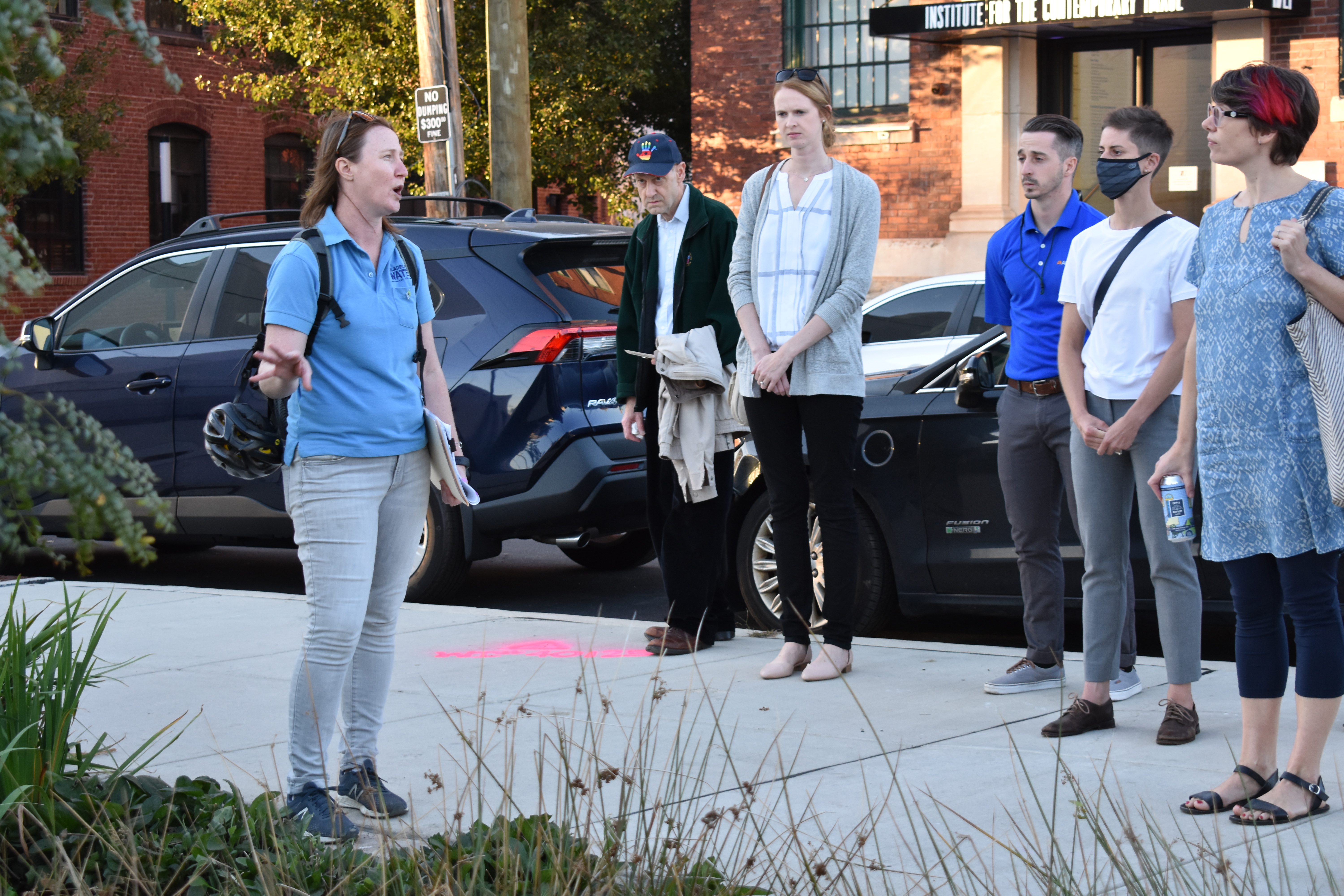
A PWD engineer gives a tour of GSI on American Street – one of the largest Green City, Clean Waters projects to date created in partnership with the Streets Department.
Complimenting the Streets Department work, the Office of Transportation, Infrastructure, and Sustainability (oTIS), looks to incorporate sustainability into as many projects as possible in order to meet the City’s environmental goals.
In particular, oTIS helps lead the City’s Vision Zero program, ‘a strategy to eliminate all traffic-related deaths and severe injuries, while increasing safety, health, and mobility for all.’
PennDOT, SEPTA, and PIDC also contribute significantly to the creation of Complete and Green Streets in Philadelphia.
“The Streets Dept congratulates PWD on 10 years of Green City, Clean Waters,” says Former Chief Engineer and President/Board of Surveyors at Philadelphia Streets Department Darin L. Gatti. “Our working partnership has resulted in both an increase in the construction of green streets and a more efficient use of taxpayer dollars which positively impacts the safety and beauty of roadways in Philly neighborhoods. We look forward to continuing to help PWD meet stormwater requirements and protect local waterways for years to come. Kudos and well deserved!”
PWD, the Streets Department, and project partners have collectively finished nearly 1,000 projects to date, which manage more than 17 million gallons of stormwater runoff per typical storm event. That’s equivalent to over 28 Olympic-sized swimming pools* full of polluted water that no longer flow into our waterways!
*Or 580+ Septa buses, or 240,000+ bathtubs, or almost 311,400 55-gallon rain barrels per storm.
Also underscoring our progress here is the amazing work done by the City’s Office of Sustainability (OoS), including their new resilience and environmental justice work.
“Protecting and expanding access to our natural resources, including installing Green Stormwater Infrastructure throughout Philly’s neighborhoods, is one of the best solutions to fighting climate change,” says Christine Knapp, Director of the Office of Sustainability. “By making one of the largest investments in sustainability in the city’s history, the Green City, Clean Waters program is helping make a healthy, vibrant, and climate resilient city for all. Congratulations on 10 years of excellence. We look forward to collaborating together in the years to come.”

Let us introduce you to a few more partners…
From organizations within our city borders to peer utilities across the country, PWD’s network gives us the ability to push stormwater management at nearly every level, including local, state, and regional groups who bring more resources and focus to Green City, Clean Waters.
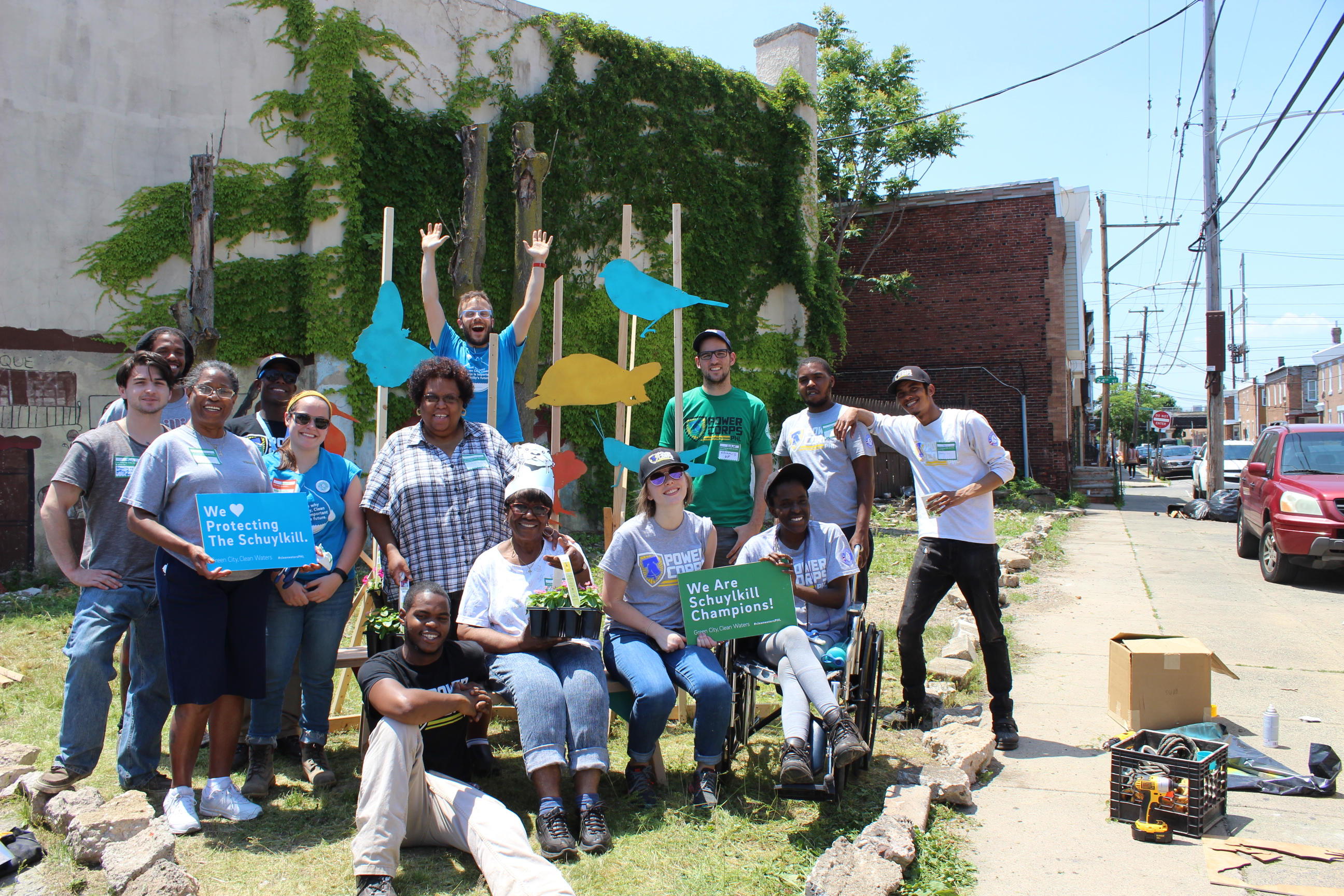
In 2017, PWD’s GSI team joined PowerCorpPHL, The Public Workshop, and local residents at a cleanup of Point Breeze.
While there are so many to thank, a sample of the local-level MVPs (most valuable partners) include water-focused educators at the Fairmount Water Works Interpretive Center (FWWIC), PWD-founded creek heroes at the Tookany/Tacony-Frankford (TTF) Watershed Partnership, staff at the Pennsylvania Horticultural Society (PHS) that help us manage Rain Check, visionary urban artists at Mural Arts, the green jobs training programs of PHL PowerCorps, the formalized network of green contractors established by the Sustainable Business Network (SBN), and our own Green City, Clean Waters Action & Advisory Committees.
All of these groups are made up of facilitators and decision makers from every corner of the city with a focus on education and engagement around urban waters.
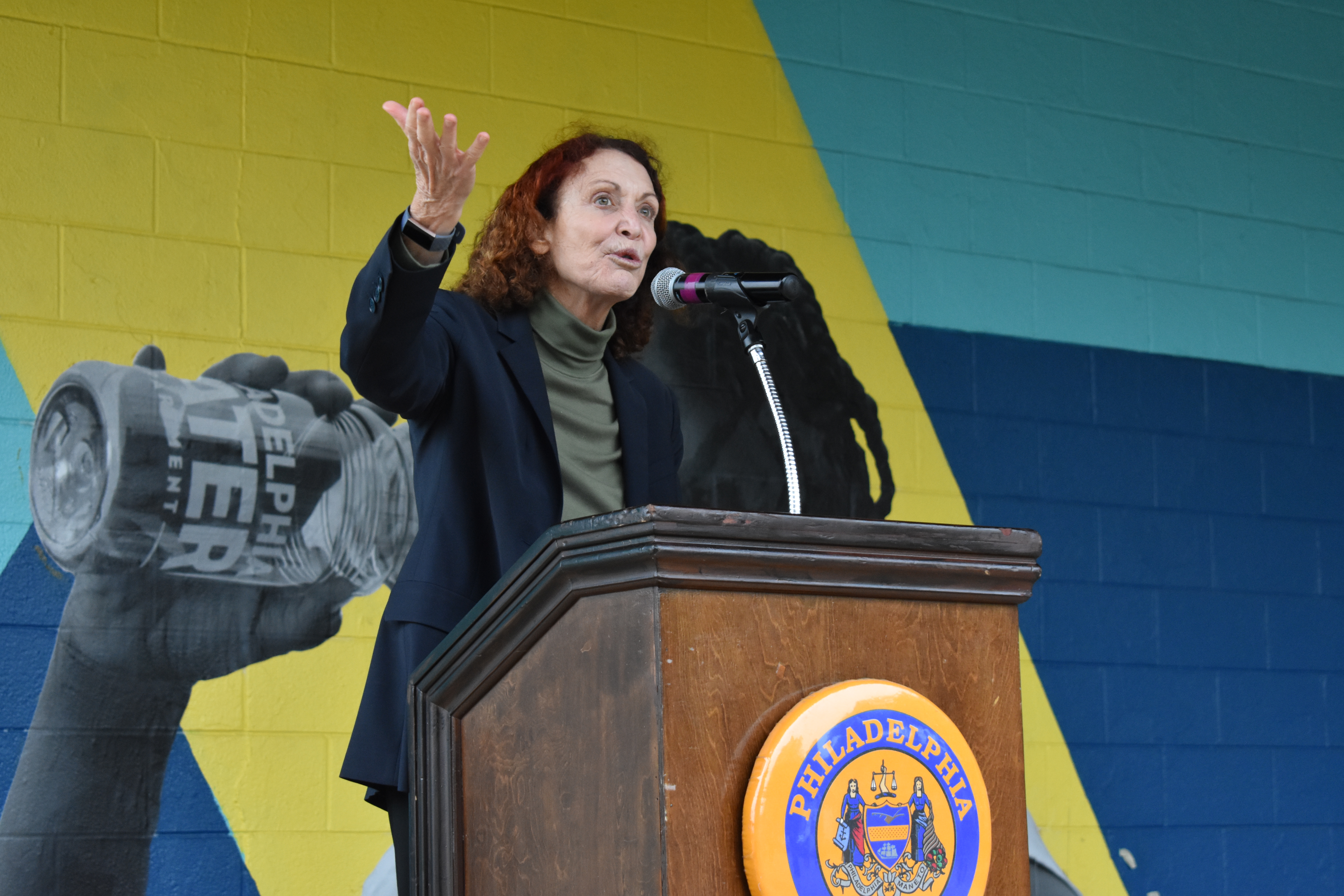
Mural Arts Philadelphia Executive Director/Founder Jane Golden speaks at a PWD mural unveiling.
“Mural Arts wants to congratulate the Philadelphia Water Department for 10 years of thinking creatively, fearlessly, and passionately on Green City, Clean Waters,” says Jane Golden, Founder & Executive Director of Mural Arts Philadelphia. “PWD understands that art has the power to work on behalf of citizens across the city and sees art as a tool of advocacy, education, and inspiration. We look forward to our continued partnership in bringing critical water-related issues to view for residents of every neighborhood.”
“The Sustainable Business Network recognizes and celebrates the role that Green City, Clean Waters has had on the growth of our region’s local economy, its commitment to greening our local waterways, and in making Philadelphia a healthier and more resilient city,” says Alex Cupo, SBN GSI Partners Manager. “Congratulations to the Philadelphia Water Department! We look forward to supporting the plan’s goals in the years to come!”
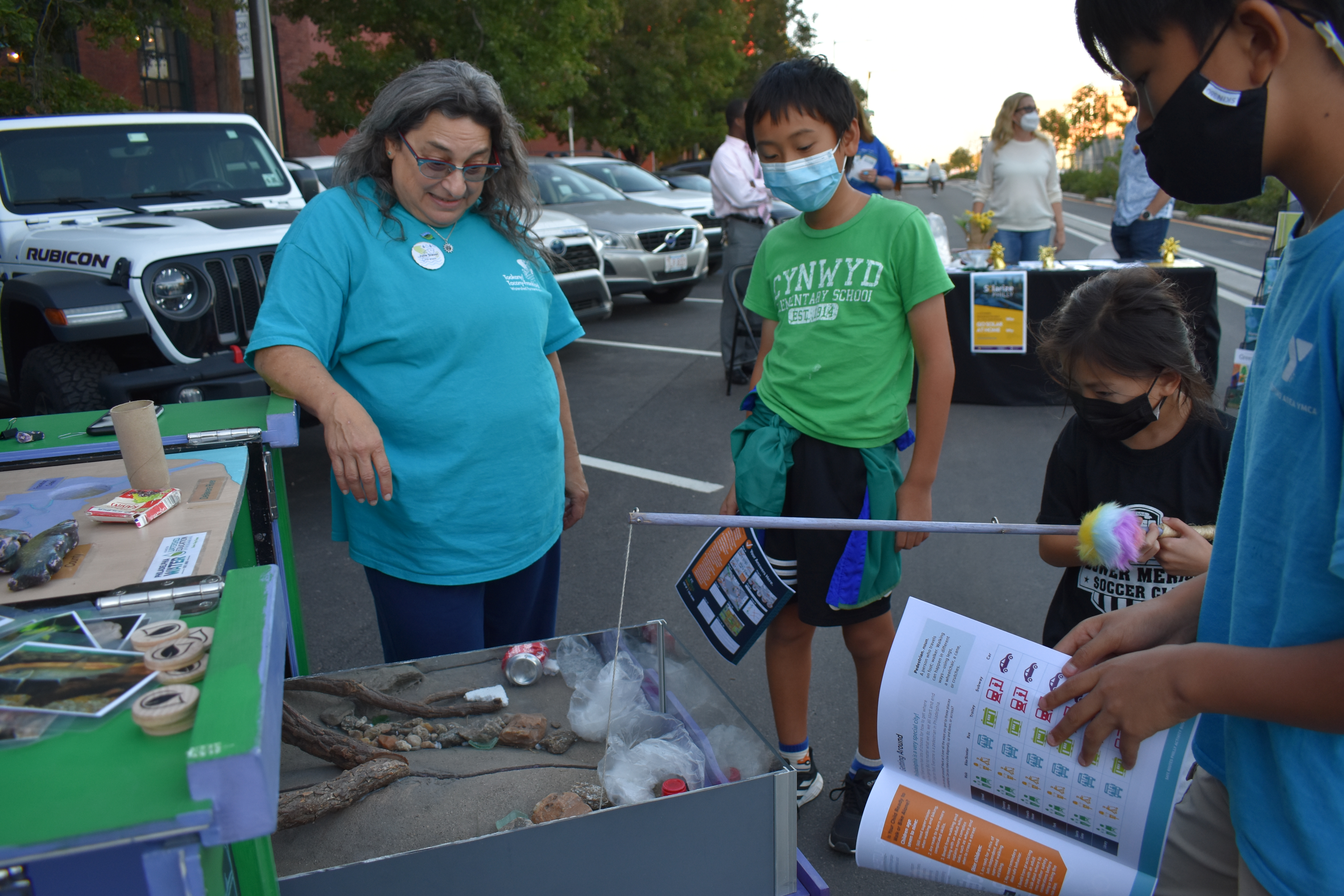
Julie Slavet, Executive Director of TTF, with the Creekmobile educational tool.
“A commitment to both clean water and collaboration is at the heart of our work at the Tookany/Tacony-Frankford (TTF) Watershed Partnership – and at the heart of Philadelphia’s Green City, Clean Waters,” says Julie Slavet, Executive Director of TTF. “We have had lots of fun connecting people to creeks by sharing the community benefits of green stormwater infrastructure (GSI) through projects like our first rain garden in Germantown’s Vernon Park, our Soak It Up Adoption sites, and our innovative Creekmobile, cleanups, and plantings. We’re always proud to share the lessons of GCCW across our neighborhoods and entire watershed with our eye on the goal of cleaner creeks.”
At the regional level, nonprofits like the Schuylkill Action Network (SAN) and the Partnership for the Delaware Estuary (PDE) work for the waterways and watersheds above and below us. The Trust for Public Land (TPL) steps in to help green schoolyards, and the Pennsylvania Environmental Council (PEC) offers us state-wide expertise on stormwater management solutions applicable in rural, suburban, or urban environments.
“PWD’s successes with GCCW are emblematic of the Department’s multi-faceted approach and commitment to clean water that we have witnessed through our ongoing partnership in the Schuylkill Action Network (SAN) watershed collaborative,” says Meghan Rogalus, Schuylkill Action Network (SAN) Manager. “PWD has been a key partner since the SAN’s formation in 2003, notably serving on multiple regional, issue-focused workgroups to further efforts to create healthier local waterways and directly fund on-the-ground improvements that translate to cleaner water for all downstream. PWD is truly a partner in both name and deed. We are grateful for their dedication to facilitating strong communication and relationships to promote clean water throughout the Schuylkill River watershed.”
We also can’t forget the Soak It Up Adoption (SIUA) partners caring for constructed green infrastructure in their neighborhoods and every single ‘Friends-Of’ group and registered community organization (RCO) who engage with us to make Philly as ‘green’ as possible.

Thank you for Celebrating!
From 2021 to 2022, PWD took on a significant digital communications enterprise: capturing the last 10 years of Green City, Clean Waters.
Working with such a multi-faceted program, we decided to tackle this coverage through various lenses, including engagement, residents, businesses, and jobs.
This major undertaking to clean our waterways has benefited several areas of our lives—and it all exists in the collective care for our creeks and rivers.
From organizations funding colossal projects to residents maintaining neighborhood rain gardens—and all of those in-between—we can’t thank you enough.
With your support, we continue to grow closer to our goal of 85% local water pollution reduction by 2036.
